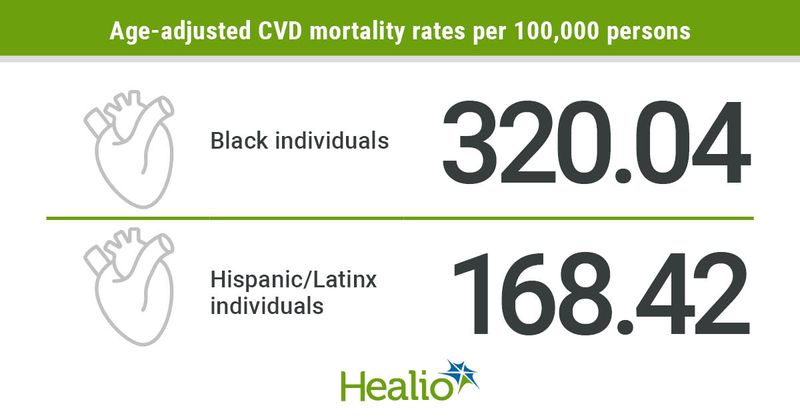Factors influencing CVD mortality vary by region, race, ethnicity
County-level factors affecting CVD mortality vary by race and ethnicity, researchers reported.
The researchers conducted an analysis based on 2017 county-level CVD age-adjusted mortality rates extracted from CDC data for all age groups.

Black Americans had the highest CV death rate nationally, and county-level factors such as demographics, census region, socioeconomics, CVD risk factors and health care access contributed to CVD death differently across different races and ethnicities, the researchers wrote.

“We looked at CV mortality by race and ethnicity, as well as county-level predictors of CV mortality,” Justin T. Parizo, MD, advanced heart failure fellow at Stanford University, told Healio.
The researchers developed univariate and multivariable linear regression models to determine the association between each county-level factors and CVD age-adjusted mortality rates for non-Hispanic white individuals, non-Hispanic Black individuals and Hispanic/Latinx individuals.
In the cohort, there were 659,740 CVD deaths among non-Hispanic white individuals in 2,624 counties, 100,475 CVD deaths among non-Hispanic Black individuals in 717 counties and 49,493 CVD deaths among Hispanic/Latinx individuals in 267 counties.
According to the researchers, Black individuals had the highest mean CVD age-adjusted mortality rate (320.04 deaths per 100,000 individuals) nationwide, which was 29% higher than that for non-Hispanic white individuals (248.69 deaths per 100,000 individuals).
In contrast, Hispanic/Latinx individuals had the lowest mean CVD age-adjusted mortality rate (168.42 deaths per 100,000 individuals) nationwide.
The variation across counties in CVD mortality had a different predominant explanation for different races/ethnicities. In non-Hispanic white individuals, the greatest variation was explained by CVD risk factors such as smoking, physical activity, diabetes and obesity (R2 = 35.3%), whereas for non-Hispanic Black individuals, the greatest variation was explained by socioeconomic factors such as education level, employment level, food insecurity and household income (R2 = 25.8%), and for Hispanic individuals, the greatest variation was in demographic factors such as population size, rurality, sex breakdown, race/ethnicity breakdown and census region (R2 = 34.9%), the researchers wrote.
According to Parizo, the key takeaway from the study is that at the county level, the factors that contribute to CV mortality are diverse and vary across ethnic and racial groups.
“We have supporting evidence to previous literature showing that socioeconomic factors should be considered a greater risk factor than previously thought. The importance of socioeconomic risk factors, including things like food insecurity should be a focus of future studies evaluating population interventions that improve cardiovascular health,” Parizo told Healio.
For more information:
Justin T. Parizo, MD, can be reached at Division of Cardiovascular Medicine, Stanford University, 870 Quarry Road, Falk Cardiovascular Research Center, Stanford, CA 94305-5406; email: jparizo@stanford.edu.
